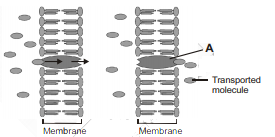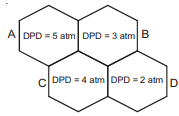In mycorrhiza, fungal filaments help in
1. Water absorption
2. Food translocation
3. Developing tension in xylem
4. Development of root pressure
Non-living components of xylem tissues are involved in
1. Symplast pathway
2. Apoplast pathway
3. Osmosis
4. Active transport
Symplast pathway of water in plants is not related to
1. Vacuolar path
2. Cytoplasm
3. Plasmodesmata
4. Cell wall
Hydathodes help in
1. Bleeding
2. Guttation
3. Protection against grazing
4. More than one option is correct
The water rises in straw due to suction, it is due to
1. Positive hydrostatic pressure
2. Negative hydrostatic pressure
3. Zero hydrostatic pressure
4. Diffusion pressure
Transport proteins of _________are control points, where a plant adjusts the quantity and types of solutes that reach the xylem
1. Hypodermis
2. Endodermis
3. Pith
4. Pericycle
The casparian strips of root endodermis is made up of
1. Suberin
2. Cellulose
3. Chitin
4. Keratin
Identify the means of transport represented below and the structure marked as A
1. Simple diffusion; A – Transport protein
2. Facilitated diffusion; A–Transport protein
3. Facilitated diffusion; A–Transport pumps
4. Active transport; A–Transport pumps
Facilitated diffusion is characterized by all, except
1. Requirement of membrane proteins
2. Uphill transport
3. No requirement of energy
4. Highly selective nature
Water channels are
1. Made up of eight similar types of aquaporins
2. Involved in active transport
3. Involved in facilitated diffusion
4. More than one option is correct
As a result of endosmosis, of cell
1. Increases
2. Decreases
3. Remains same
4. Become zero
Which of the following equation is wrong?
1.
2.
3.
4.
Correct expression for water potential of plasmolysed cell will be
1.
2.
3.
4.
When a cell is fully turgid, which of the following will be zero?
1. Osmotic pressure
2. Turgor pressure
3. Wall pressure
4. Suction pressure
A hypothetical arrangement of plant cells (A, B, C, and D) is given below
Find the correct sequence of movement of water using the given values
(1) D B C A
(2) A C B D
(3) D B A C
(4) D A C B
Find correct pathway of movement of water in given presentation of cells.
1. 
2. 
3. 
4. 
Phenomenon not associated with root pressure is
1. Sap exudation
2. Bleeding
3. Guttation
4. Transpiration
Phenomenon of guttation
1. Is regulated by Cohesion-Tension
2. Is due to active solute accumulation by phloem
3. Takes place to release excessive solutes
4. More than one option is correct
A. In dry atmosphere, the relative humidity is low, so the rate of transpiration increases
B. Slow breeze promotes the rate of transpiration
C. ABA promotes transpiration
D. A high salt concentration in soil water increases transpiration
1. C and D are correct
2. B and C are correct
3. A and C are correct
4. A and B are correct
A. Most researchers agree that water is mainly ‘pulled’ upward through the plant, where transpiration is the driving force.
B. Less than one percent of water reaching the leaves is used in plant growth and photosynthesis.
C. Cobalt chloride paper turns blue on absorbing water.
1. All are correct
2. Only C is incorrect
3. Only B is incorrect
4. Only A is correct
According to the pressure flow hypothesis
A. Phloem loading produces a hypertonic condition in the sieve tubes.
B. Water potential gradient facilitates the mass movement in the phloem.
C. Phloem unloading is a passive process.
1. A & B are incorrect
2. B & C are incorrect
3. A & B are correct
4. A & C are correct
Although a girdled (upto bast) tree may survive for sometime, but it will eventually die because
1. Water will not move upward
2. Water will not move downward
3. Sugars and other organic solutes will not move downward
4. Sugars and other organic solutes will not move upward
Transpiration and root pressure cause water to rise in plants by
1. Pushing and pulling it, respectively
2. Pulling it upward
3. Pulling and pushing it, respectively
4. Pushing it upward
Lenticels are involved in
| 1. | Gaseous exchange | 2. | Food transport |
| 3. | Photosynthesis | 4. | Transpiration |
Which one of the following structures between two adjacent cells is an effective transport pathway?
1. Plasmalemma
2. Plasmodesmata
3. Plastoquinones
4. Endoplasmic reticulum
Given below is the diagram of a stomatal apparatus. In which of the following all the four parts labelled as A, B, C and D are correctly identified?
| 1. | A – Subsidiary cell B – Epidermal cell C – Guard cell D – Stomatal aperture |
| 2. | A – Guard cell B – Stomatal aperture C – Subsidiary cell D – Epidermal cell |
| 3. | A – Epidermal cell B – Guard cell C – Stomatal aperture D – Subsidiary cell |
| 4. | A – Epidermal cell B – Subsidiary cell C – Stomatal aperture D – Guard cell |
Potometer works on the principle of
1. Amount of water absorbed equals the amount transpired
2. Osmotic pressure
3. Root pressure
4. Potential difference between the tip of the tube and that of the plant
When water moves through a semipermeable membrane then which of the following pressure develops?
1. Osmotic pressure
2. Suction pressure
3. Turgor pressure
4. Wall pressure
With an increase in the turgidity of a cell, the wall pressure will
1. Fluctuate
2. Remain unchanged
3. Increase
4. Decrease
Stomatal opening is affected by
1. Nitrogen concentration, carbon dioxide concentration and light
2. Carbon dioxide concentration, temperature and light
3. Nitrogen concentration, light and temperature
4. Carbon dioxide concentration, nitrogen concentration and temperature
Opening and closing of stomata is due to the
1. Hormonal change in guard cells
2. Change in turgor pressure of guard cells
3. Gaseous exchange
4. Respiration
Stomata of a plant open due to
1. Influx of potassium ions
2. Eflux of potassium ions
3. Influx of hydrogen ions
4. Influx of calcium ions
The movement of water, from one cell of cortex to adjacent one in roots, is due to
1. Accumulation of inorganic salts in the cells
2. Accumulation of organic compounds in the cells
3. Water potential gradient
4. Matrix potential gradient
Which of the following is the most accepted theory for movement of water through plants?
1.Cohesion tension theory
2. Capillarity
3. Imbibition theory
4. Root pressure
The translocation of organic solutes in sieve tube members is supported by
1. Cytoplasmic streaming
2. Root pressure and transpiration pull
3. P-proteins
4. Mass flow involving a carrier and ATP